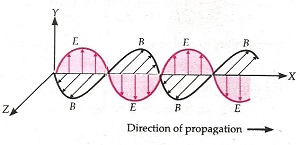Electromagnetic Waves-Revision Notes
CBSE Class 12 Physics
Revision Notes
Chapter-8
Electromagnetic Waves
- Displacement Current: It is due to the time-varying electric field -
Displacement current acts as a source of a magnetic field in exactly the same way as conduction current. - Maxwell's equations:
- Gauss law of electrostatics-
- Gauss law of magnetism-
- Faraday's law of electromagnetic induction-
- Modified form of Ampere's circuital law-
- Electromagnetic Waves: These waves propagate through space as coupled electric and magnetic fields, oscillating perpendicular to each other and to the direction of propagation of the wave.

- Electromagnetic waves are produced only by charges that are accelerating, since acceleration is absolute, and not a relative phenomenon.
- An electric charge oscillating harmonically with frequency , produces electromagnetic waves of the same frequency .
- An electric dipole is a basic source of electromagnetic waves.
- Electromagnetic waves with a wavelength of the order of a few meters were first produced and detected in the laboratory by Hertz in 1887. He thus verified a basic prediction of Maxwell’s equations.
- Electromagnetic waves are transverse in nature.
- They do not require any material medium for their propagation.
- Oscillation of Electric and Magnetic Fields: These oscillate sinusoidally in space and time in an electromagnetic wave. The oscillating electric and magnetic fields, E and B are perpendicular to each other and to the direction of propagation of the electromagnetic wave.
- For a wave of frequency , wavelength , propagating along the z-direction
- Relation between and : The speed c of an electromagnetic wave in vacuum is related to and (the free space permeability and permittivity constants) as
- The value of c equals the speed of light obtained from optical measurements. Electromagnetic waves other than light also have the same velocity c in free space.
- Speed of Light: The speed of light, or of electromagnetic waves in a material medium is
where is the permeability of the medium and its permittivity.
- Electromagnetic waves carry energy as they travel through space and this energy is shared equally by the electric and magnetic fields.
- Energy Per Unit Volume: If in a region of space in which there exist electric and magnetic fields , there exists Energy Density (Energy per unit volume) associated with these fields is,
where we are assuming that the concerned space consists of the vacuum only. - Electromagnetic waves transport momentum as well. When these waves strike a surface, a pressure is exerted on the surface.
- If total energy transferred to a surface in time t is U, total momentum delivered to this surface is p = .
- Electromagnetic Spectrum: The orderly distribution of the electromagnetic waves in accordance with their wavelength or frequency into distinct groups having widely differing properties is called an electromagnetic spectrum.
- The classification has more to do with the way these waves are produced and detected.
- Different Regions of Spectrum: Different regions are known by different names; -rays, X-rays, ultraviolet rays, visible rays, infrared rays, microwaves, and radio waves in order of increasing wavelength from to
(a) Radio Waves: These are produced by accelerated motion of charges in wires. These are used in radio and television communication systems. These are generally in the frequency range from 500 kHz to about 1000 MHz or wavelength range is greater than 0.1 m.
(b) Microwaves: These are short-wavelength radio waves with a frequency range 109 Hz to 1012 Hz or wavelength range 0.1 m to 1 mm. Due to their short wavelengths, they are suitable for radar systems used in aircraft navigation. Microwave ovens use them for cooking.
(c) Infrared Waves: Frequency range or wavelength range 1 nm to 700 nm. These are produced by hot bodies and molecules. They lie adjacent to low frequency or long wavelength end of the visible spectrum.
(d) Visible Light: The spectrum frequency runs from about 4 x to about 7 x or wavelength range 700 - 400 nm. Our eyes are sensitive to this range of wavelengths.
(e) Ultraviolet light: It covers frequency range from or wavelengths range from 400 nm to 1 nm. The sun is an important source of UV rays.
(f) X-rays: It covers a frequency range from or wavelengths ranges from 1 nm to 10-3 nm. It is used in medical diagnosis.
(g) Gamma Rays: These lie in the upper frequency range 1018Hz to 1022Hz of the spectrum, and have wavelengths in the range less than 10-3 nm. It is used in manufacture of polyethylene from ethylene.